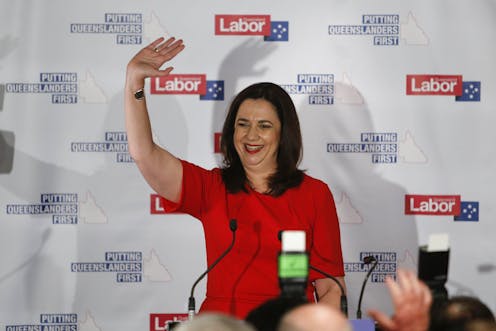 This is not the clear-cut election result Annastacia Palaszczuk and Labor hoped for.AAP/Glenn Hunt
This is not the clear-cut election result Annastacia Palaszczuk and Labor hoped for.AAP/Glenn HuntAfter going to the polls on November 25, Queenslanders finally have a state election result as Liberal National Party leader Tim Nicholls conceded defeat on Friday.
Following a four-week campaign, votes were counted for almost a fortnight until Annastacia Palaszczuk’s Labor Party was confirmed the victor. Palaszczuk is the first female premier to win back-to-back elections. In 2015, she’d become the first woman at state or federal level to lead her party to government from opposition.
But it’s not the clear-cut result Palaszczuk desired. Labor appears to have won 48 seats in the 93-member parliament to the LNP’s 39. This leaves Palaszczuk’s returned government with a slim majority and a diverse crossbench.
A complex contest
With a record field of candidates in an expanded number of electorates – many with redrawn boundaries – this shaped as a complicated election. Adding to its unpredictability was the reintroduction after 25 years of compulsory preferential voting.
Further reading: With One Nation on the march, a change to compulsory voting might backfire on Labor
While two-party-preferred swings were generally not as large as at the last two state elections, overall figures showed a fragmented statewide vote. More than 30% gave their first preferences to minor parties and independents. This exceeded the One Nation-driven protest vote in 1998.
This continues the trend of a declining primary vote for the major parties. Combined with compulsory preferencing, several electorate contests duly developed into three- or even four-horse races, extending the time needed to correctly distribute preferences and declare results. Some seats were decided only after the arrival of postal votes, up to ten days after the polling date.
Like the previous Queensland and federal elections, a close and protracted count left the government in extended caretaker mode. Voters in Queensland and the rest of Australia may need to accustom themselves to a new norm of tight, drawn-out contests, where party leaders’ election night speeches might be obsolete.
Winners and losers
Labor went into the election with a notional seat count of 48 following the redistribution. Despite a 2% decline in its statewide vote, it emerges with little change in its electoral stocks.
Gains in the state’s southeast corner at the LNP’s expense offset a few seat losses in central and north Queensland, where persistent unemployment has been a worry.
To the government’s relief, every cabinet member held their seat. Deputy Premier Jackie Trad survived one of the stronger challenges, a 10% two-party-preferred swing to the Greens in South Brisbane. Brisbane’s inner suburbs, as in other state capitals, are now highly vulnerable to a rising green tide.
The LNP suffered a negative swing of almost 8% – and even higher in parts of the southeast. High-profile casualties included shadow frontbenchers Scott Emerson, Ian Walker, Tracey Davis and Andrew Cripps in the north falling victim to erratic preference flows.
Emerson has the distinction of losing the newly created seat of Maiwar in inner Brisbane to Queensland’s first elected Greens MP, Michael Berkman.
In other firsts, Labor’s new member for Cook in far-north Queensland, Cynthia Liu, is the first Torres Strait Islander elected to any Australian parliament. Innovation Minister Leanne Enoch becomes the state’s first Indigenous MP to be returned at an election.
One Nation’s Stephen Andrew, who defeated veteran Labor MP Jim Pearce in Mirani in central Queensland, becomes the first descendent of South Sea Islander labourers to enter state parliament.
Decisive issues
Besides bread-and-butter issues of job creation, power prices and transport infrastructure, neither Palaszczuk nor Nicholls could escape the dominant themes of this election. The proposed Adani coal mine project animated voters in different parts of the state for different reasons, as did the spoiler role that Pauline Hanson’s One Nation was presumed to play.
Together, these factors reinforced an impression of “two Queenslands” in contention during the campaign.
Further reading: Adani aside, North Queensland voters care about crime and cost of living
Protests against the Adani mine’s environmental impact – and questions over its long-term economic benefit to regional communities – featured regularly once the election was called. Palaszczuk succeeded in defusing the issue to some extent early in the campaign with an abrupt declaration that she would veto federal infrastructure funding for the mine’s construction.
Further reading: Why Adani may still get its government loan
A feared backlash in places of regional discontent and high youth unemployment, like Townsville, didn’t entirely materialise, with Labor incumbents holding seats against expectations. But these concerns, in tandem with uncertainty over the Adani project, saw Labor lose Bundaberg and nearly lose the traditionally Labor-voting Rockhampton to independent candidate and former mayor Margaret Strelow.
The LNP’s position on supporting the Adani mine with public funds, and Nicholls’ prevarication over dealing with One Nation, appear to have hurt the party in Brisbane especially. But so too did Labor reminding voters of Nicholls’ role as treasurer in the Newman government.
As the election neared, Nicholls was swamped by constant questioning about cosying up to One Nation.
While always difficult to quantify, the federal Coalition government’s woes amid the same-sex marriage debate and citizenship fiasco likely did the LNP few favours.
Role of the minor parties
The Greens and One Nation capitalised on the dip in major party support, gaining significant vote shares of 10% and almost 14% respectively. However, each party won only a single seat.
Critically, both parties stripped valuable primary votes from Labor and the LNP, especially the latter’s vote in the regions. This will furrow the brows of federal Coalition MPs through this term of government. For good measure, One Nation preferences likely helped unseat some LNP MPs in the southeast.
The party’s state leader, Steve Dickson, lost out to the LNP in Buderim, while Senate outcast Malcolm Roberts didn’t present a serious threat to Labor in Ipswich.
Despite its failings, One Nation attracted more than 20% in the seats it contested and finished runner-up in two dozen of them, perhaps largely down to Hanson’s constant presence throughout the campaign.
Katter’s Australian Party (KAP), though standing candidates in only ten seats and not making much impact on the campaign, might have done best of all the minor parties. Its primary vote improved to more than 2%, gaining it another seat in Hinchinbrook on Labor and One Nation preferences.
KAP’s targeted approach might prove unwelcome news for the federal Coalition, which can expect similar levels of focused disaffection from conservative regional voters elsewhere. But a fragmenting primary vote spells trouble for all the major parties.
What next for Queensland?
Queensland now enters its first fixed-term period of government. The next election is due on October 31, 2020, with four-year terms following that.
Labor holds only 13 of 51 seats outside the Greater Brisbane area. With all seats decided, factional negotiations will now unfold to determine the make-up of Palaszczuk’s new cabinet. It’s fair to assume it will be Brisbane-centric.
With such a concentration of government MPs in the capital, Palaszczuk’s team will presumably clock up many kilometres – and spend some political capital – reassuring the regions they’re not forgotten.
In the wake of an underwhelming result for the LNP, Nicholls announced he is stepping down as party leader and won’t contest a leadership ballot early next week. The likes of David Crisafulli or Tim Mander, or potentially Deb Frecklington, loom as Nicholls’ likely successors.
Party insiders have complained that the election result proves the marriage between the formerly separate Liberal and National parties in Queensland has failed and should be broken up.
Further reading: Queensland Liberals and Nationals have long had an uneasy cohabitation, and now should consider divorce
The road ahead for both major parties will be anything but easy.
Dr Chris Salisbury is a Research Associate with Queensland's TJ Ryan Foundation.
Authors: Chris Salisbury, Lecturer in Australian Studies, The University of Queensland
| < Prev | Next > |
|---|







